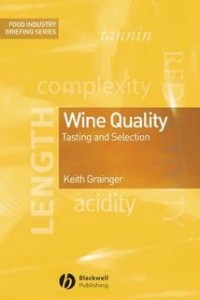Wine quality: tasting and selection, Keith Grainger
| Title of book: | Wine Quality: tasting and selection |
| Author: | Keith Grainger |
| Publisher: | Wiley-Blackwell |
| Publication date: | 2009 |
| ISBN | 978 1 4051 1366 3 |
| Pages: | 163 |
| Price: | £45.00 |

Wine Quality by Keith Grainger
Part of the food industry briefing series which “distils the subject matter of the topic, providing its essence for easy and speedy assimilation.”
The author has worked through the subject according to the standard that industry personnel are trained, detailing sight, nose and palate elements, plus the categories of conclusions to be drawn from the tasting. It is a logical, sequenced way to deal with the subject.
The introduction succinctly lays open the challenges of assessing, defining and organoleptically analysing the quality of wine in a culturally-free, absolute and objective manner.
Chapter 1 provides a good checklist of kit for a tasting, and offers a tasting order. My only quibble, apart from red before white (obvious once you’ve read it), is that the young before old is by no means a given. Any ethereal, delicate flavours of a venerable wine can easily be quashed by youthful power and vibrancy.
This book has a factual, logically-progressive text book type approach. The author treats all the components in accordance with the standard, but for such things as ‘legs’, most attention should focus on the author’s proviso paragraph, as should comments about the mousse in sparkling wine. Both are related to the condition of the glassware.
Wine faults are given appropriate prominence, and it’s enlightening to see the category broadened to ‘flaws’, which somehow seems to allow some discretion, on some of the issues, at least: as the author states, within limits, such things as volatile acidity, sulphur dioxide, reductivity and brett are subject to personal preference and become a fault only when excessive.
Extraneous, but useful, matters such as EU wine law (nomenclature and some processes changing from the 2009 vintage), wine competitions and classifications are outlined, which is good for a factual background of the legal framework of wine production.
Chapter 11, selection by buyers is a nice add-on. It has little to do with inherent wine quality and achieving quality in wine production, but it’s a nice overview of the UK market and some of the issues, not all quality-related, that buyers have to address.
There’s enough science-y stuff to keep the attention of those so inclined, but the book is still safely comprehensible if the science is too detailed. For example, one doesn’t need to know how ‘musty taint’ is formed, just how to recognise it, yet the book deals with both aspects.
Overall the book is a useful reference tool, addressing all the main issues impinging on wine quality, from growing and making, to tasting and assessing, and to legal and economic constraints, even those issues where no definitive answer yet exists, such as age of vines, vine stress, and even to some extent, yield.



